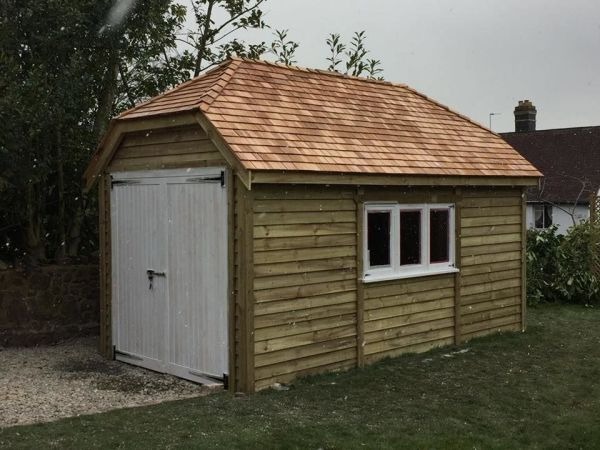4 x 14 Wooden Outbuilding Making Drawings: Details To Consider When Making A DIY Shed


The function is going to be important, since it would have a big impact on the location for your shed. Lowes typically has a better grade of building products, but this is a shed. It can be used for tiny homes, cabins, or sheds and has more flexibility for changing needs than other foundations. A ramp for the front entrance makes it easier to access shed with mowers, wheelbarrows or other large items. Whatever you decide on this measurement, it should remain (https://sheddrafts.com/8x10-backyard-wooden-shed-building-plans-blueprints) the same all around your shed. Installing trusses may seem pretty slice and dry but there are some tricks to getting them lined up right and securing them to the top plate of walls.
Now adding a bracket for bolt to extend through. If you plan to paint your shed, natural wood siding isn't necessary. If you're planning to build a garden shed, take accessibility into account. It's the kind of project that you could spread over an entire season, knocking off a chunk each week. In order to get job done as a profession, using least amount of materials and time, you need to plan everything from the very beginning. The project features instructions for building a large shed with a gambrel roof that has a significant storage space. Install door, for details on building outbuilding door click here.
If you're a good pastry chef why not show world what you can construct out of icing. Different gravel companies use different numbers or grades to identify gravel size and composition. Repeat this (find out more) four times for four walls. Connecting eaves to ceiling beams or to rafter ties helps walls resist outward thrust pressure from roof. Once you have stud walls built, the sheathing should overlap the concrete by 2 inches and have 3 inches of clearance from the ground. A 4-inch-thick cement slab with thickened edges is ultimate base, but it's also expensive and requires the most skill to prepare and finish.
Then screw subfascia to the rafter tails, running it past rafters at the pavilion end. True floor joist span calculations could only be made by a structural engineer or contractor. We chose a window that has nailing fins along the outside perimeter instead of timber brick molding. Attach sides of the post caps to corresponding sides of beam, using 16d framing nails at each of the machined nail holes. Take this 2x4 and snap a chalk line down the middle of it on the flat side. After installing all wooden trusses to top plates, you need to continue the project by fitting the gable ends.
The ridge is off-center and closer to the taller wall. If you know the rise and run of your roof, you can use this shed roof pitch calculator to help determine correct pitch. Give a little to dry and harden. Floor studs are horizontally oriented beams that create a frame on which to construct a raised floor. If the wall would have a door, lay out lumber for frame. Each must be properly framed in for maximum structural integrity. The 6x6 posts and beams were joined with mortise-and-tenon joints, but you can save time by joining 6x6s with metal timber-framing hardware.
The project itself has local historical significance. This, however, requires a bit of preparation in advance. The door you are replacing may be a different size, as is the wood door you are replacing it with. Cut each piece to correct size and angle. It might be at this point you may need to decide if you want gaps or no gaps between boards. Check the plans for exact position of ridge. Check with your chamber of commerce to find out what building codes you may need to follow with your shed's construction. This shed roof frame needs to provide sufficient protection against elements, of course, but it also should blend into surrounding aesthetics of home.
Position a floor joist on the first mark, flush with top of wall ledger, and toenail a 16d nail at a 45-degree angle through top of the floor joist into the ledger. Notching a joist could reduce its load-bearing capacity. Anchor the completed shed to outside of a building with screws through top back cross piece into the building. Set the remaining two blocks directly in center. Leave about half of the block exposed. It details all factors in roof construction, even ventilation. Ideally ridge flashing should be wide enough to cover at least 100mm along each plane of roof.
We were able to make our base framing from pressure treated lumber that had found washed up on beach.